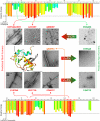Identifying the amylome, proteins capable of forming amyloid-like fibrils
- PMID: 20133726
- PMCID: PMC2840437
- DOI: 10.1073/pnas.0915166107
Identifying the amylome, proteins capable of forming amyloid-like fibrils
Abstract
The amylome is the universe of proteins that are capable of forming amyloid-like fibrils. Here we investigate the factors that enable a protein to belong to the amylome. A major factor is the presence in the protein of a segment that can form a tightly complementary interface with an identical segment, which permits the formation of a steric zipper-two self-complementary beta sheets that form the spine of an amyloid fibril. Another factor is sufficient conformational freedom of the self-complementary segment to interact with other molecules. Using RNase A as a model system, we validate our fibrillogenic predictions by the 3D profile method based on the crystal structure of NNQQNY and demonstrate that a specific residue order is required for fiber formation. Our genome-wide analysis revealed that self-complementary segments are found in almost all proteins, yet not all proteins form amyloids. The implication is that chaperoning effects have evolved to constrain self-complementary segments from interaction with each other.
Conflict of interest statement
The authors declare no conflict of interest.
Figures


References
Publication types
MeSH terms
Substances
Grants and funding
LinkOut - more resources
Full Text Sources
Other Literature Sources

